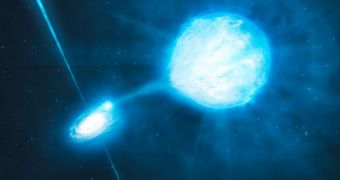Astronomers announce the discovery of the farthest black hole ever found in the Universe, the relic of a defunct star that collapsed under its own weight a long time ago. There are a number of features that make this particular space structure unique, including the fact that it is the second most massive of all similar black holes in the books (at 15 times the mass of the Sun), and also a member of a binary system, next to a star that will most likely become a black holes itself soon, Space reports.
Needless to say, this is not the second largest black hole in the Universe per se, in the sense that supermassive black holes get to be millions of times the mass of the Sun. But it is the second largest star-mass black hole, which is another story completely. Generally, these structures get to be about ten times the mass of our star, but astronomers were only able to observe them in the Local Group until now, which is in fact our galactic neighborhood. Experts also say that the newly discovered feature puts all known similar black holes around us to shame, in terms of sheer mass.
“This is the most distant stellar-mass black hole ever weighed, and it's the first one we've seen outside our own galactic neighborhood, the Local Group,” University of Sheffield astronomer Paul Crowther, who has been a member of the team that has made the finding, explains. He adds that star-mass black holes are generally considerably smaller than their supermassive counterparts, which can usually be found at the cores of massive galaxies, such as our own Milky Way.
Using the European Southern Observatory's (ESO) Very Large Telescope (VLT), in Chile, experts were able to determine the existence of the new structure some six million light-years away from us, in the spiral galaxy NGC 300. The investigation build up on previous observations of the region, made with the NASA Swift satellite. The data collected by this spacecraft in 2007 hinted at a possible black hole in the region, and the VLT was used to confirm the findings. “We recorded periodic, extremely intense X-ray emissions, a clue that a black hole might be lurking in the area,” European Space Agency (ESA) team member Stefania Carpano explains.
What surprised researchers was the fact that they also discovered a Wolf-Rayet star accompanying the star-mass black hole. This is a type of massive star that is approaching the end of its burning cycle, and that is scheduled to sooner or later shed all of its atmosphere in its surroundings, and implode its core to form a new black hole. This particular one has a mass of about 20 times that of the Sun, so it will most certainly collapse into a black hole. For now, the material it sheds from its atmosphere becomes food for its companion. Once the Wolf Rayet star dies too, it will form a binary black hole system together with the already existing one.

 14 DAY TRIAL //
14 DAY TRIAL //